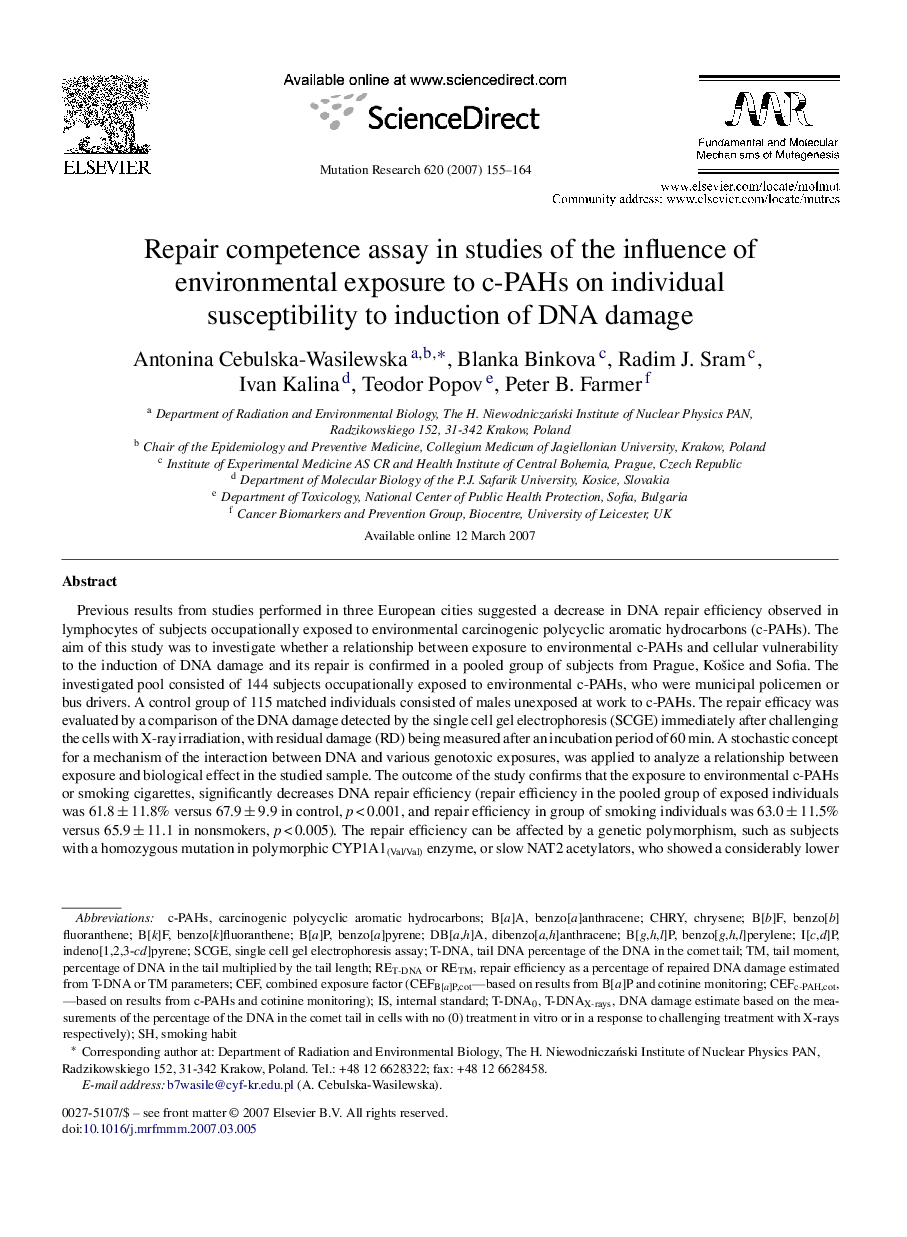| Article ID | Journal | Published Year | Pages | File Type |
|---|---|---|---|---|
| 2147371 | Mutation Research/Fundamental and Molecular Mechanisms of Mutagenesis | 2007 | 10 Pages |
Abstract
Previous results from studies performed in three European cities suggested a decrease in DNA repair efficiency observed in lymphocytes of subjects occupationally exposed to environmental carcinogenic polycyclic aromatic hydrocarbons (c-PAHs). The aim of this study was to investigate whether a relationship between exposure to environmental c-PAHs and cellular vulnerability to the induction of DNA damage and its repair is confirmed in a pooled group of subjects from Prague, Košice and Sofia. The investigated pool consisted of 144 subjects occupationally exposed to environmental c-PAHs, who were municipal policemen or bus drivers. A control group of 115 matched individuals consisted of males unexposed at work to c-PAHs. The repair efficacy was evaluated by a comparison of the DNA damage detected by the single cell gel electrophoresis (SCGE) immediately after challenging the cells with X-ray irradiation, with residual damage (RD) being measured after an incubation period of 60 min. A stochastic concept for a mechanism of the interaction between DNA and various genotoxic exposures, was applied to analyze a relationship between exposure and biological effect in the studied sample. The outcome of the study confirms that the exposure to environmental c-PAHs or smoking cigarettes, significantly decreases DNA repair efficiency (repair efficiency in the pooled group of exposed individuals was 61.8 ± 11.8% versus 67.9 ± 9.9 in control, p < 0.001, and repair efficiency in group of smoking individuals was 63.0 ± 11.5% versus 65.9 ± 11.1 in nonsmokers, p < 0.005). The repair efficiency can be affected by a genetic polymorphism, such as subjects with a homozygous mutation in polymorphic CYP1A1(Val/Val) enzyme, or slow NAT2 acetylators, who showed a considerably lower DNA repair efficiency (i.e. average repair efficiency in subgroups of fast acetylators was for the control subgroup 68.1% versus 66.5% in exposed subjects, while in the case of subgroups of slow acetylators, for the control group was 68.0% versus significantly less in the exposed subjects, 60.6%, p < 0.05). Smoking habits, or the diet's vitamin content, significantly affected the process. The results obtained confirm a potential value of the method as a biomarker of susceptibility in molecular epidemiology or preclinical studies, aimed at predicting susceptibility to various genotoxic exposures (environmental, occupational, therapeutic). To conclude, the research proved the influence of environmental c-PAHs, genotypes, and life styles on DNA damage and on its repair efficiency. Even low exposure to environmental c-PAHs altered DNA repair abilities of the subjects, which may result in an increased cancer risk. The findings confirm that c-PAHs should become pollutants that are subject to regulation.
Keywords
DB[a,h]ASCGEIndeno[1,2,3-cd]pyrenedibenzo[a,h]anthraceneT-DNAc-PAHsB[a]ACEFB[k]FB[b]FB[a]PSingle cell gel electrophoresis assayinternal standardBenzo[a]anthraceneBenzo[a]pyreneBenzo[b]fluorantheneBenzo[k]fluorantheneDNA repairStochastic approachSmoking habitcarcinogenic polycyclic aromatic hydrocarbonsCHRYchrysene
Related Topics
Life Sciences
Biochemistry, Genetics and Molecular Biology
Cancer Research
Authors
Antonina Cebulska-Wasilewska, Blanka Binkova, Radim J. Sram, Ivan Kalina, Teodor Popov, Peter B. Farmer,
